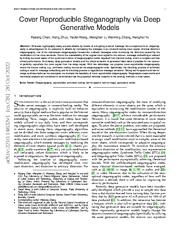A copy of this work was available on the public web and has been preserved in the Wayback Machine. The capture dates from 2022; you can also visit the original URL.
The file type is application/pdf.
Cover Reproducible Steganography via Deep Generative Models
[article]
2022
arXiv
pre-print
Whereas cryptography easily arouses attacks by means of encrypting a secret message into a suspicious form, steganography is advantageous for its resilience to attacks by concealing the message in an innocent-looking cover signal. Minimal distortion steganography, one of the mainstream steganography frameworks, embeds messages while minimizing the distortion caused by the modification on the cover elements. Due to the unavailability of the original cover signal for the receiver, message
arXiv:2210.14632v1
fatcat:ofkav7l2eja4thery4wdvzl2o4

